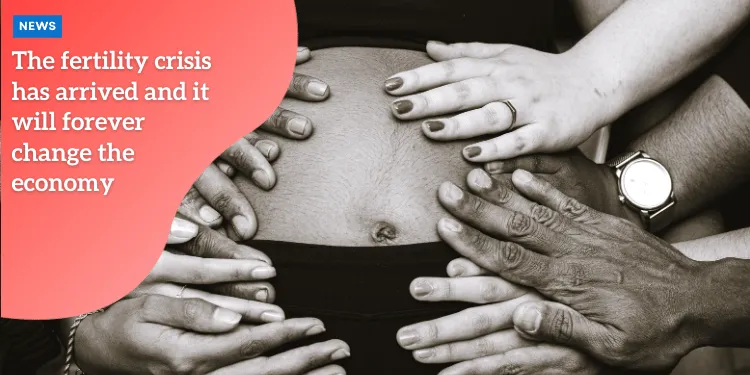The fertility crisis has arrived and it will forever change the economy

The world is facing a significant challenge: a sharp decline in birth rates.
Economists have long warned that decreasing fertility rates could lead to numerous economic issues, such as a shrinking labor force, increased inflation, disruptions in consumer spending, and strained government resources dedicated to supporting an aging population.
Anúncios
These concerns are no longer speculative; they are becoming a reality.
A recent study by the Organisation for Economic Co-operation and Development (OECD) indicates that declining birth rates will fundamentally transform the demographic landscape of the world’s largest economies in the coming decade.
The Declining Birth Rates
According to projections, by 2064, the global death rate is expected to surpass the birth rate for the first time in modern history.
Anúncios
However, many of the world’s leading economies are already experiencing this demographic shift.
In 2022, the total fertility rate among the OECD’s 38 member countries dropped to 1.5 children per woman, down from 3.3 children in 1960.
This rate is significantly below the replacement level of 2.1 children per woman, which is necessary to maintain a stable population.
Anúncios
The implications are stark.
The supply of workers in many countries is rapidly decreasing. In the 1960s, there were six working-age individuals for every retired person, according to the World Economic Forum.
Today, that ratio has dropped to approximately three-to-one. By 2035, it is projected to fall to two-to-one.
Over the past decade, top executives at publicly traded US companies have cited labor shortages nearly 7,000 times during earnings calls, as reported by the Federal Reserve Bank of St. Louis.
Economic Consequences
A declining share of workers can lead to labor shortages, which may increase employees’ bargaining power and drive up wages, ultimately contributing to inflation.
This view was articulated by Simona Paravani-Mellinghoff, managing director at BlackRock, in a recent analysis.
While net immigration has historically helped mitigate demographic challenges in wealthy nations, the shrinking global population is making this solution less viable.
Advanced economies may soon struggle to import labor from other regions, either through migration or by outsourcing production.
By 2100, only six countries are projected to have fertility rates high enough to maintain their populations: Chad, Niger, Somalia, Samoa, Tonga, and Tajikistan, according to research published in The Lancet.
Preparing for the Future
Business leaders and policymakers are already strategizing for this demographic downturn.
Elon Musk, who has twelve children, has cautioned that falling birth rates might lead to “a civilization that ends quietly, with adults in diapers.”
Though his comment is provocative, it underscores a genuine issue.
Companies like Procter & Gamble and Kimberly-Clark, which dominate the US diaper market, have reported declining sales of baby diapers in recent years.
However, sales of adult diapers have been a growing segment of their business.
Other companies are also shifting their focus towards older consumers.
Nestlé’s CEO, Mark Schneider, has indicated that the company is prioritizing products that cater to the nutritional needs of people over 50, rather than infant formula.
Governmental Responses
Governments are also taking action. French President Emmanuel Macron has introduced a plan for “demographic revitalization,” which encompasses fertility testing and increased parental leave.
Former US President Donald Trump has promised to support “baby bonuses” to encourage a new baby boom if re-elected.
The Centers for Disease Control and Prevention (CDC) reported that the US birth rate in 2023 fell to an all-time low, reversing a slight increase observed during the Covid-19 pandemic.
The Congressional Budget Office (CBO) forecasts that within the next 15 years, the number of deaths will exceed the number of births.
These findings are crucial for the agency’s economic forecasts and budget projections.
Increased spending on programs like Medicare and Social Security is inevitable as the baby boomer generation ages.
Fewer workers will be available to support the growing number of retirees receiving these benefits.
Social Security payments currently account for about 90% of income for more than a quarter of older adults in the US.
Without intervention, the Social Security trust fund is projected to be depleted by the mid-2030s, resulting in reduced benefits for retirees.
Technological Solutions
Some see advancements in technology, particularly artificial intelligence (AI), as a potential remedy.
Former Google CEO Eric Schmidt has pointed out the demographic crisis caused by insufficient birth rates, stating that there will be a shortage of workers for the next 30 years.
AI, he suggests, could alleviate some of these issues by boosting productivity.
Goldman Sachs predicts that generative AI could increase global GDP by up to 7% over a decade.
However, the impact of AI on the global economy remains uncertain.
Analysts at the Federal Reserve Bank of Richmond estimate that AI could enhance labor productivity by 1.5% to 18% over the next ten years, which could be either minimal or substantial.
Long-Term Strategies
To address declining fertility rates, long-term solutions must focus on promoting gender equality and a more equitable distribution of work and childrearing responsibilities.
This includes providing more paid parental leave and financial support for families.
Stefano Scarpetta, director for employment, labor, and social affairs at the OECD, emphasizes that these measures are essential for preparing for a “low-fertility future.”
Furthermore, creating environments that allow for better work-life balance and offering flexible work arrangements can make a substantial difference. By fostering a culture that supports both careers and family life, societies may begin to reverse the fertility decline, or at least slow its effects.
In conclusion, the fertility crisis is no longer a distant issue but a current reality that will have lasting effects on the global economy.
Governments, businesses, and society must adapt to this new demographic landscape to mitigate the economic challenges ahead.
The era of low fertility is upon us, and its impact will be profound and enduring.
The demographic crisis also presents significant social challenges.
With fewer young people to care for the aging population, support networks and healthcare systems may become overwhelmed.
The rise of automation and artificial intelligence can help fill some gaps, but these technological solutions won’t solve all the problems.
Additionally, cultural changes are needed to address the decline in birth rates.
It’s important not just to encourage higher birth rates but also to change social norms to support gender equality and a balanced distribution of family and caregiving responsibilities between men and women.
Initiatives that promote collaboration in childcare and health, along with public policies that make parenting more financially accessible, will be key to addressing long-term challenges.
The economic and social transformation required will need coordinated efforts from governments, businesses, and communities to ensure a sustainable future for all.





